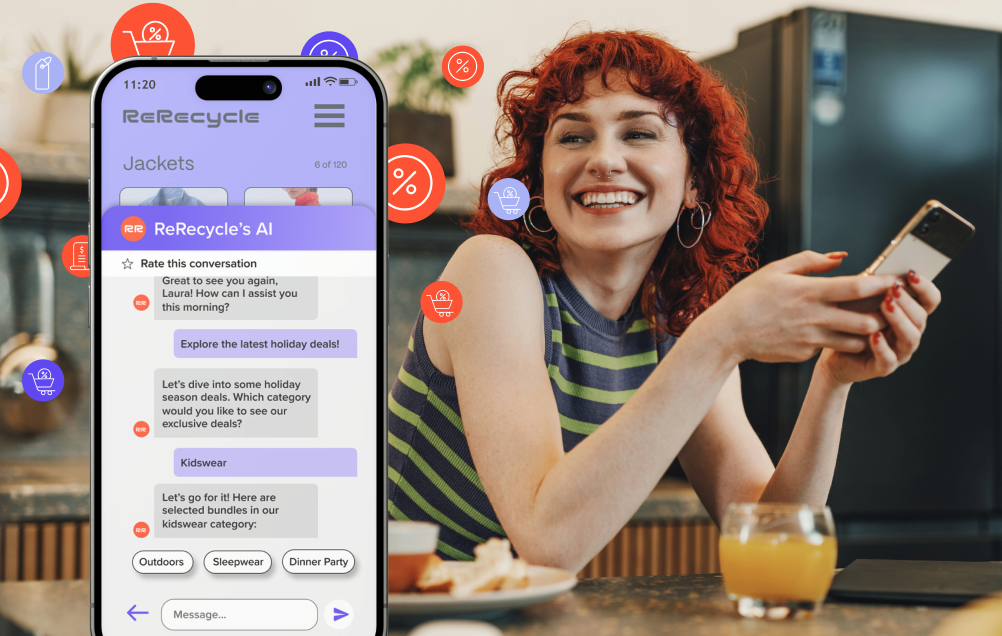What is Conversational Shopping
Despite the rise in technology and the ever-present narrative that robots are going to take over the world, consumers still crave a human touch when shopping. It’s the reason brick-and-mortar stores still exist: People enjoy going to their local shop, browsing real-life products on real-life shelves, and interacting with sales staff.
But the human nature of shopping has been difficult to replicate online–until now. Conversational shopping (also known as conversational commerce) has made it possible for shoppers to enjoy a personalized shopping experience through a screen.
What is Conversational Shopping?
Conversational shopping is the phrase used to describe an omnichannel approach to online commerce where consumers can interact with a brand through messaging apps. They can access customer support, ask questions, get personalized product recommendations, and find relevant content all from within one conversational shopping app or chatbot.
Consumers are able to access real, human representatives through these channels, but they can also get answers from an automated chatbot if they have a more urgent matter. This helps brands serve customers around the clock and provide a personalized conversational retail experience without the need to employ hundreds more members of staff.
Conversational shopping combines AI-powered technology and human sales associates to:
- Ensure customers have the right assistance during the buying process
- Gently nudge shoppers through the sales funnel with timely reminders and notifications
- Introduce shoppers to new and highly-relevant products
- Learn more about each customer’s unique wants and needs
- Provide support and recommendations to existing customers
It’s a win-win situation for both brand and consumer since customers can get their questions answered in the moment and brands can reach customers who are actively in buy mode, build trust, and ultimately convert them with personalized content and recommendations.
3 Examples of Conversational Shopping in Action
While conversational shopping loosely refers to conversations that occur and influence the buying journey, it’s most prevalent in three channels:
- Chatbots: Chatbots on eCommerce websites are the norm now. Shoppers can get instant answers, discover relevant content, and get help with their purchase decisions without the need to speak to a real-life agent.
- Live chat agents: While chatbots can deliver lots of information to shoppers, they can’t do everything. That’s where live chat agents come in. For unique questions and special situations, shoppers can reach out to real-life representatives to get help and answers.
- Messaging apps: Messaging apps like Facebook Messenger and WhatsApp have added features that let brands connect with their customers on conversational retail platforms they’re already on.
What Conversational Shopping Can Do
1. Guide Customers Along the Customer Journey
Conversational shopping aims to resolve any objections or hesitations shoppers have as they move through the buying process. As well as delivering personalized product recommendations suited to their needs, it can answer questions about dispatch and shipping, and direct shoppers to social proof, like customer reviews, blog posts, and user-generated content.
Providing exactly the right content at exactly the right time can help keep shoppers moving seamlessly through the customer journey.

Jewelry brand Pavoi uses Rep for conversational shopping to give shoppers information about how to look after their products and provides answers to common questions.
2. Help Customers Find Relevant Products
Shoppers want convenience. They don’t want to have to scroll through pages and pages of products to find what they’re looking for–it’s why someone will head straight to the counter in a brick-and-mortar store and ask for help.
Chatbots replicate this experience online by asking a series of questions to understand what a shopper is looking for and then directing them straight there. This can also take the form of personalized product recommendations. As well as suggesting the product a shopper is after, you can also recommend other similar products they might be interested in.

Herbaly helps shoppers find the right product by breaking them down into categories based on what health problem they help.
3. Answer Specific Product-Related Questions
If a customer can’t get the information they need when they need it, they’re going to go elsewhere. Conversational shopping helps eliminate this by providing the answers to pre-purchase questions. For example, a shopper might want more information about the size and fit of a pair of jeans before they take the plunge. If you can’t provide them with that information while they’re on-site and in buy mode, there’s a good chance they’ll go elsewhere.
Chatbots can deliver automated responses to these questions (or, at the very least, direct shoppers to the right information) to keep hesitations low and shoppers on track to buy.

Ritual Zero Proof answers common product-related questions to give shoppers the information they need, exactly when they need it.
4. Direct Shoppers to Relevant Pages
Your product category pages are like the different departments of a brick-and-mortar store. Conversational shopping uncovers what a customer needs–whether it’s the direct link to a specific product, information about shipping, or a blog post about a cocktail recipe they can use with their latest purchase–and direct them to the right page.

Clothing brand THEY directs shoppers to relevant pages, depending on if they’re interested in discovering new products or simply want to know what the returns policy is.
5. Promote Upsells and Cross-Sells
Upselling and cross-selling products at the point of purchase can give you a boost in revenue and increase customer trust at the same time. Conversational shopping allows you better understand what each individual customer is looking for and serve them relevant upsell and cross-sell recommendations.

Fresh Roasted Coffee asks shoppers what they’re looking for and then directs them to the right page so they don’t have to scroll through pages of products they’re not interested in. In this instance, it upsells bundles to shoppers.
How Rep’s AI-Powered Chatbot Makes Conversational Shopping Easy
Conversational shopping hits two birds with one stone: It increases conversion rates and frees up your human representative’s precious time. Rep’s AI-powered chatbot bolsters your conversational shopping efforts by identifying distracted customers who are about to exit, delivering relevant content, and offering personalized product recommendations.
This ultimately increases conversion rates, average order value, and lifetime value while decreasing the number of customer service tickets by offering real-time assistance and guidance for visitors who are about to abandon the website, seem disengaged, or just want help and recommendations.
Sign up and create an account with Rep to unlock the power of an AI e-commerce chatbot.
Quick Answers and FAQs
How can chatbots and messaging apps enhance the customer support experience in conversational shopping?
Immediate Availability and Response
Customers often need assistance outside business hours when human agents aren't available. AI chatbots solve this problem by providing 24/7 support, answering questions instantly without making customers wait. This immediate response capability significantly increases customer satisfaction while reducing abandonment rates.
Unlike traditional support channels, chatbots can handle multiple inquiries simultaneously, ensuring no customer is left waiting in a queue during peak shopping periods.
✅ Automated responses to common questions
✅ Round-the-clock availability
✅ Instant answers to product queries
Personalized Shopping Assistance
When a customer struggles to find the right product among thousands of options, they often abandon their search entirely. Chatbots analyze browsing history and preferences to deliver tailored recommendations that match individual needs.
Most eCommerce sites make the mistake of showing generic product suggestions. What actually works is AI-powered personalization that considers previous purchases, viewed items, and stated preferences to create a truly customized shopping experience.
Seamless Omnichannel Support
Messaging platforms like WhatsApp and Facebook Messenger allow brands to meet customers where they already spend their time. This integration creates a frictionless experience that feels natural and convenient.
Do this: Maintain conversation context when customers switch between devices or channels
Not that: Force customers to repeat information they've already provided
What role do personalized experiences and customer data play in developing an effective conversational commerce strategy?
Customer data serves as the foundation for meaningful conversational commerce. When brands collect and analyze browsing patterns, purchase history, and previous interactions, they create comprehensive customer profiles that power personalized experiences. This data-driven approach transforms generic exchanges into relevant conversations that feel tailored to each shopper's unique needs.
Customer data collection essentials:
- Behavioral signals (product views, time spent)
- Purchase history and abandoned carts
- Interaction preferences (channel, time, tone)
- Demographic information
The real magic happens when this data activates in real-time conversations. A shopper who previously browsed running shoes might receive targeted recommendations when they return, creating a sense of being understood rather than just being sold to.


.png)










